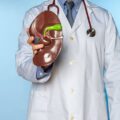Comment:
Nonalcoholic fatty liver disease (NAFLD) refers to the development of hepatic steatosis in the absence of secondary causes. Contrarily to nonalcoholic steatohepatitis (NASH), which refers to inflammation and ballooning with or without fibrosis, NAFLD involves all histopathological changes. Other than weight control through lifestyle modification (regular exercise and consumption of a Mediterranean diet), no therapy currently exists for the treatment of NAFLD.
This review by Paternostro R, Trauner M. summarises currently available and future treatment options for patients with NAFLD.
Key learnings:
Current guidelines cite pharmacotherapy as an option purely for NASH patients with significant fibrosis, as well as those with a less severe disease but with a high risk of disease progression. However, once NASH and/or advanced fibrosis is diagnosed, patients have an increased risk for liver-related complications and mortality. As such, screening for hepatocellular carcinoma should be carried out in cirrhotic patients every six months. Furthermore, lifestyle modifications and treatment of comorbid conditions should be conducted in all NAFLD patients, and pharmacotherapy should be directed towards those with biopsy-proven NASH.
Considerable efforts to develop potent pharmacological treatments are currently underway. Peroxisome proliferator-activated receptors (PPAR) agonists have shown great promise in recent trials. In a recent Phase 2b trial, the Pan-PPAR agonist Lanifibranor was associated with the resolution of NASH without worsening of fibrosis.
Other compounds, like GLP-1 agonists and FXR ligands, are also in development, and combination therapies have been touted as a potential solution to achieving NASH resolution and fibrosis improvement.


Hepatic inflammatory responses in liver fibrosis